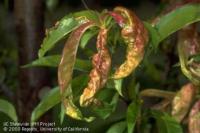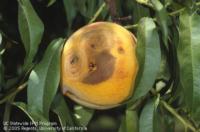Peaches, problems
-
Peach leaf curl
Peach leaf curl is a disease caused by a fungus. Peach leaf curl affects the blossoms, fruit, leaves, and shoots of peaches, ornamental flowering peaches, and nectarines, and is one of the most common disease problems for backyard gardeners growing these trees. The distorted, reddened foliage that it causes is easily seen in spring. When severe, the disease can reduce fruit production substantially.
Peach leaf curl first appears in spring as reddish areas on developing leaves. These areas become thickened and puckered, causing leaves to curl and severely distort. The thickened areas turn yellowish and then grayish white. Later affected leaves turn yellow or brown and can remain on the tree or may fall off; they are replaced by a second set of leaves that develop more normally. The loss of leaves and the production of a second set result in decreased tree growth and fruit production. Defoliation in spring may expose branches to sunburn injury.
Peach leaf curl also infects young, green twigs and shoots. Affected shoots become thickened, stunted, distorted, and often die. Only rarely does the fungus develop on fruit. Later in the season these infected areas of fruit become corky and tend to crack. If leaf curl infection builds up and is left uncontrolled for several years, the tree may decline and need to be removed.
Management To prevent peach leaf curl, use resistant peach and nectarine varieties where possible. For nonresistant varieties, treat trees with a fungicide every year after leaves have fallen. In cooler northern locations leaf fall usually is in late November. In warmer southern locations leaf fall can be as late as early January. Generally a single early treatment when the tree is dormant is effective, although in areas of high rainfall or during a particularly wet winter, it might be advisable to apply a second spray late in the dormant season, preferably as flower buds begin to swell but before green leaf tips are first visible.
Resistant Varieties A few peach varieties are available that are resistant or partially resistant to leaf curl. Currently available resistant varieties include Frost, Indian Free, Muir, and Q-1-8.
Physical Controls Although symptoms of leaf curl are seen primarily in spring as new leaves develop, there is little you can do to control the disease at this time. Some people remove diseased leaves or prune infected shoots, but this has not been shown to improve control. Normally, diseased leaves fall off within a few weeks and are replaced by new, healthy leaves, unless it is rainy.
If a tree is severely affected with peach leaf curl this can stunt its growth, so consider thinning fruit later in the season. If leaf curl symptoms occurred on your trees in spring, be sure to treat the following fall and/or winter to prevent more serious losses the following year.
Fungicide Application Thorough coverage with any fungicide is essential to obtain adequate disease control. Trees should be sprayed to the point of runoff or until they are dripping.
When using pesticides, always read and follow the label for usage, rates, toxicity, and proper disposal. Proper protective clothing and gear including goggles should be used when handling any pesticides.Read more about Peach Leaf Curl.
Brown rot fungus
Blossoms on plants infected with brown rot fungus turn brown and wither. Dead blossoms often cling to twigs for a long time. Sunken, brown areas may develop around twigs at the base of infected flowers, causing leaves at the tips of twigs to shrivel up. Brown or tan spots spread rapidly over the fruit surface and produce spores.
Life Cycle of brown rot fungus
The fungus that causes brown rot survives the winter in infected twigs, inside dead, blighted blossoms that remain on the tree, or in dried, rotted fruit on the tree or on the ground. Spores are carried through the air by wind and splashing water to infect flowers in the spring. Fruit is most susceptible to infection by the brown rot fungus when it is ripe. Most fruit rot develops during the month before harvest, although rot occasionally may develop on green fruit in early summer.
Read more about the life cycle of brown rot fungus.
Solutions
Remove and destroy fruit mummies and diseased plant parts promptly. This prevents the buildup of the fungus and helps keep rot below damaging levels. Prune trees to allow good ventilation. Avoid wetting blossoms, foliage, and fruit when irrigating. Plant varieties that are least susceptible; check with your local nurseryman.
If you have had problems in the past, applications of copper-containing or synthetic fungicides such as myclobutanil at pink bud stage can help avoid serious losses. Additional applications when fruit starts to color may be needed if rainy weather persists. Do not apply copper compounds after bloom.
Read more about copper containing fungicides.
Read more about the synthetic fungicide myclobutanil.
Read more about brown rot on peaches.
Losing leaves
Losing leaves in the fall is normal. Peach and nectarine trees are deciduous, meaning they lose their leaves beginning in the fall and go dormant through the winter. They will bud and bloom in the spring, go through their fruit bearing cycle in summer, then lose leaves again next fall.
Read more information about pests and diseases of peaches.


